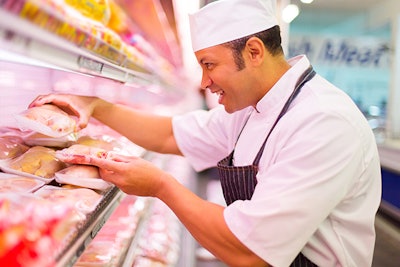
Price is a concern for many meat and poultry shoppers going into 2023, but that doesn’t mean that the industry should be concerned.
“Of course, we all know that inflation drove the conversation in 2022, and not just in meat,” Anne-Marie Roerink, president, 210 Analytics LLC, said during “The Power of Meat 2023: An In-Depth Look at Meat Through the Shopper’s Eyes” at the 2023 Annual Meat Conference.
Despite this, the demand for meat remains strong, she added.
The Power of Meat Survey is conducted annually and the presentation of the survey was sponsored by Cryovac. Roerink highlighted 10 survey findings that retailers and poultry and meat processors can utilize to better serve the U.S. retail consumer.
1. How can we win with meat?
With inflation dominating the conversation, retailers need to be innovative in how they market meat. Rising prices means that consumers are eating at home more and dining out less. This means that they are looking to replicate the restaurant experience – primarily through the use of air fryers and other novel cooking devices or already-marinated meats.
Retail can take advantage of this opportunity by pointing out the cost-effectiveness of cooking and providing shoppers with the items that make cooking simple and easy.
Holidays are another way that retail can win over consumers. Valentine’s Day and Mother’s Day are two holidays that are traditionally associated with eating out. Creating displays that make celebrating the holiday at home easy and cost-effective can sway consumers.
2. Online meat is gaining on supermarkets
E-commerce grew exponentially during the COVID-19 pandemic. While the number of consumers purchasing meat has stayed constant, they are purchasing more meat online than ever.
3. Case-ready wins, but service counter is for special occasions
Case-ready meat use continues to grow with consumers in 2023. Consumers indicated in the Power of Meat survey that they use both self-service and the Butcher’s counter when it comes to meat selection, but the facts show that they overwhelmingly choose case-ready.
However, this fact changes when it comes to specialty cuts or specialty occasions. In this case, shoppers like that they have an expert to turn to at the full-service counter.
4. Eating meat remains the norm, but price is a concern
Eating meat is still the norm for consumers. In fact, fewer consumers are defining themselves as flexitarians than a few years ago. According to the survey, 4 out of 4,6 home-prepared meals are prepared with meat.
The biggest changes in meat shopping over the past year are primarily related to price due to inflation. Sale ads and coupons are playing a big role in the poultry and meat cuts consumers purchase and they’re putting more of a focus on price over quality, welfare and sustainability, Roerink added.
5. Attitudes on cultivated meat are changing
Three years ago, few people know what cultivated meat was. Attitudes are changing and more and more consumers indicate an openness for trying the alternative protein over the past few years.
Cost, however, remains a concern. The price of cultivated meat production is still much higher than traditional animal protein.
6. People still don’t understand poultry welfare
Only five in ten respondents believe that the welfare of animals used for food production, including poultry, is good. This shows that more education on behalf of the industry is needed and retail should share in this responsibility, Roerink said.
Local farms are viewed as having better welfare as well as cage-free, free-range and organic production systems, according to the survey. When it comes to animal welfare, respectful handling and outdoor access continue to top the list of consumer concerns.
7. Sustainability is important
Over the past few years, a broader definition of sustainability has emerged for consumers. The term now encompasses environmental impact, welfare and the social impact. Respondents in the Power of Meat survey indicated that sustainability is critical to them when it comes to purchasing meat and poultry, particularly when it comes to red meat production, social responsibility and packaging waste.
Particularly when it comes to social responsibility, Roerink said that the protein industry isn’t getting the credit it deserves.
8. The hybrid meal is taking over U.S. kitchens
Meat remains the centerpiece of the U.S. meal, but retail needs to make sure they are helping consumers with planning, shopping and prepping.
Convenience is key when it comes to meals at home nowadays, with people feeling that they have less time than ever. Value-added is an easy way to provide convenience. New appliances – air fryers, sous vide and Instant Pots – give consumers another easy way to prepare meat and poultry at home.
In addition, consumers are tired of what they typically cook. They’re looking online to social media for meal inspiration. Recipes are going viral.


















